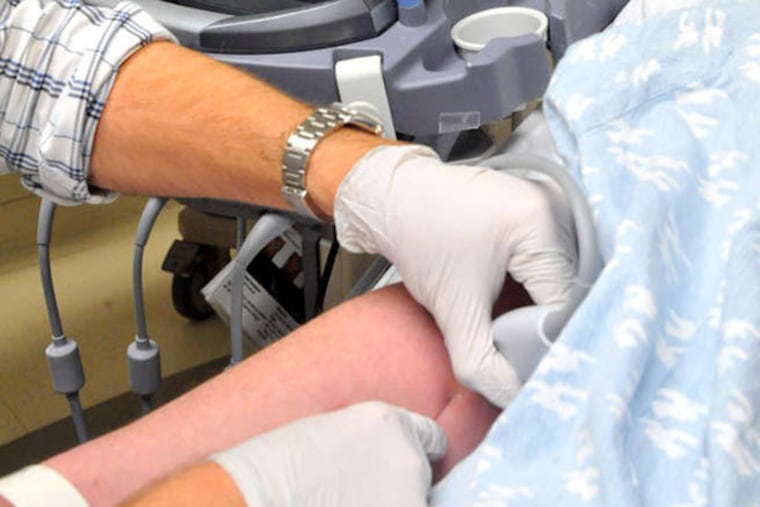Ultrasound helps patients with 'difficult' veins
Matt Fields, an emergency physician at Thomas Jefferson University Hospital, is using ultrasound to insert IVs more accurately in patients at high risk of multiple needle sticks. His goal - not yet achieved - is one stick per patient.

I learned I have "difficult" veins when I was a teenager having my wisdom teeth removed.
While trying to insert an intravenous line for anesthesia, a nurse stuck my arm over and over until she found the vein. I left with half a dozen bruises. That wasn't the last time an attempt to find my blood vessels left me black and blue.
So I was intrigued when I heard that Matt Fields, an emergency physician at Thomas Jefferson University Hospital, was using ultrasound to insert IVs more accurately in patients at high risk of multiple needle sticks. His goal - not yet achieved - is one stick per patient.
Taking this on, Fields said, is "one of the more gratifying things I can do in the ER. I've had patients call me their hero."
Veins can be difficult because they're small or hard to see. People who've had many needle sticks have scarring in their vessels. Some diseases may also reduce tissue quality.
The use of small, portable ultrasound machines to assist with IV placement has been growing in recent years, particularly in large teaching hospitals like Jefferson. New emergency medicine residents now learn to use ultrasound as part of their training, and older doctors are catching up.
Experts said the technique was spreading to smaller community hospitals and other units where IVs are inserted. Hospitals are also training nurses and technicians to use the machines to find veins. (Jefferson, which doesn't charge extra for use of the device, plans that training this summer.)
Ultrasound is routinely used for placing bigger central lines in the neck or groin. Where it's becoming more common now is in what doctors call peripheral lines, the ones that usually go in patients' forearms.
"It's a game-changer in terms of how we practice," said Ryan Stanton, an emergency physician in Lexington, Ky., who's a spokesman for the American College of Emergency Physicians.
Having a needle plunged into the arm fewer times is, of course, less painful for patients. But Fields said there were other benefits. Using ultrasound means difficult patients can be treated more quickly, reducing ER waiting times. In research he presented last week at the Society for Academic Emergency Medicine's annual meeting, he found it took an extra 50 minutes to place lines in people with difficult veins. Fields said patients have told him they've delayed going to the hospital because they dreaded the IV placement.
Hamid Shokoohi, an emergency physician at George Washington University Hospital, found that use of central lines, the fallback when the staff can't connect to a peripheral vein, fell by 80 percent after technicians learned how to use ultrasound. That's important because central lines are more expensive and prone to infections.
Shokoohi said 25 percent to 30 percent of GW patients now get ultrasound-guided IV placement.
Physicians said the machine, which Stanton says costs $70,000, is used after nurses or techs try a few times and fail. "If you've done it twice and you can't get it, it's time to call somebody else," Stanton said. "I'm kind of a 'two sticks and you're out' guy."
Fields wants to do better. He asks nurses to seek his help before the first stick if they expect to have trouble. To develop a screening tool, he studied who's at high risk. He found that a quarter of patients in the ER get stuck more than once and 12 percent three or more times.
Key risk factors, he said, are patients with visibly difficult veins or a history of difficult access, diabetes, chronic health problems that needed many blood draws, sickle cell disease, and past IV drug abuse.
He showed me how ultrasound works with a young man who did not want his name used due to his past drug use. Five attempts to insert an IV had failed and he seemed to accept it as punishment for past behavior. "I've done damage to my body over the years," he said. "It's just part of what I have to go through now."
Fields placed the round head of the ultrasound wand near the crook of the patient's elbow. A fuzzy black-and-white picture that would look familiar to any mother emerged on the screen. "When you see the baby, tell me," the patient joked.
What Fields saw was a cross section of the man's arm. Blood vessels appeared as dark-centered circles. There was a good candidate a centimeter below the skin. "There's no way you would be able to feel this vein just by examining him on the surface," Fields said.
He numbed the skin, picked a longer-than-usual needle, and began threading it into the vein. He said it usually takes only three to five minutes to do everything, but this vein, perhaps due to stage fright, was challenging. Fields eventually got the IV in.
For fun, he looked at my arm. I've long joked that I can't get really sick because nurses would soon run out of places for IVs. Fields could see why predecessors had struggled. My veins just don't pop to the surface. With the machine, he saw a good one near the inside of my elbow and another at the back of my arm.
With ultrasound, he said, it would be "very easy" to put in an IV. That's good to know, but I'm hoping he never has to prove it.